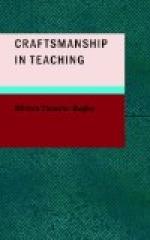Some of the most stimulating and clarifying discussions of educational problems that I have ever heard have been made in the sessions of this Society. You have been scientific in your attitude toward education, and I may add that I first learned the lessons of the real science of education in the St. Louis schools, and under the inspiration that was furnished by the men who were members of this Society. What I knew of the science of education before I came to this city ten years ago, was gleaned largely from books. It was deductive, a priori, in its nature. What I learned here was the induction from actual experience.
My very first introduction to my colleagues among the school men of this city was a lesson in the science of education. I had brought with me a letter to one of your principals. He was in the office down on Locust Street the first Saturday that I spent in the city. I presented my letter to him, and, with that true Southern hospitality which has always characterized your corps, he took me immediately under his wing and carried me out to luncheon with him.
We sat for hours in a little restaurant down on Sixth Street,—he was my teacher and I was his pupil. And gradually, as the afternoon wore on, I realized that I had met a master craftsman in the art of education. At first I talked glibly enough of what I intended to do, and he listened sympathetically and helpfully, with a little quizzical smile in his eyes as I outlined my ambitious plans. And when I had run the gamut of my dreams, he took his turn, and, in true Socratic fashion, yet without making me feel in the least that I was only a dreamer after all, he refashioned my theories. One by one the little card houses that I had built up were deftly, smoothly, gently, but completely demolished. I did not know the ABC of schoolcraft—but he did not tell me that I did not. He went at the task of instruction from the positive point of view. He proved to me, by reminiscence and example, how different are actual and ideal conditions. And finally he wound up with a single question that opened a new world to me. “What,” he asked, “is the dominant characteristic of the child’s mind?” I thought at first that I was on safe ground—for had I not taken a course in child study, and had I not measured some hundreds of school children while working out a university thesis? So I began with my list. But, at each characteristic that I mentioned he shook his head. “No,” he said, “no; that is not right.” And when finally I had exhausted my list, he said to me, “The dominant characteristic of the child’s mind is its seriousness. The child is the most serious creature in the world.”




